Wanna vote? Stay tuned
September 26, 2014
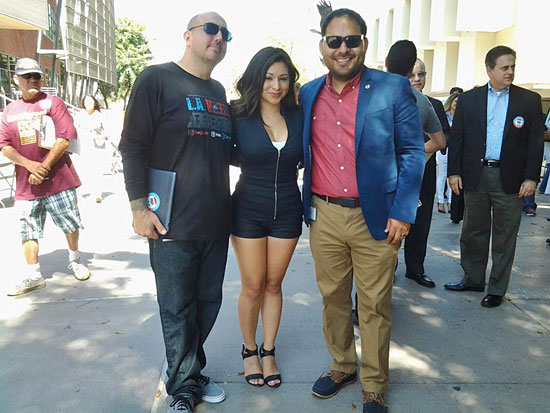
Rikki Martinez of Power 106 with Registrar-Recorder staffers Efrain Escobedo, right, and Phillip Verbera.
Power 106 may be where hip hop lives. But it’s also home to a big part of Los Angeles County’s strategy for getting new voters into the booth.
Yes, that was Power 106 radio personality Rikki Martinez posing for photos this week during a Cal State L.A. voter registration event with Registrar-Recorder staff, including the boss, Dean Logan.
“Ain’t no way I’m go’n let OUR voice go unheard,” Martinez said in her National Voter Registration Day tweet to 33,000-plus Twitter followers (including Logan.)
Don’t touch that dial: it’s a brand new era in voter outreach in L.A. County.
Buoyed by successful partnerships with radio stations during the last presidential election year, 2012, the Registrar-Recorder is seeking to turn things up a notch with the approach of mid-term elections—traditionally a tougher time to engage and motivate would-be participants in the electoral process.
Efrain Escobedo, who helped pioneer the department’s work with radio stations two years ago, said that traditional models—like setting up voter registration tables at events—just aren’t enough to get the job done anymore.
With more than 1 million potential voters in the county still unregistered, he said, it makes sense to turn to radio, with its strong built-in relationships across a variety of platforms. Beyond listening in the car during L.A.’s endless rush hours, audiences stream radio programming on their computers at work and home, while using their cell phones to call in for contests or text in for ticket giveaways.
“The way people live their lives today has changed. Their devices are a central part of how they live their lives and people use media in a much different way than they used to,” said Escobedo, the Registrar-Recorder’s manager of governmental and legislative affairs. “We’re probably not the best messengers. So we identified radio stations to be a medium that is all about having a direct relationship with the listener.”
Tactics like text-back campaigns, in which people vying for free concert tickets get a text message reply urging them to register online, already have proven their value.
Now it’s time to go deeper.
“This year, we’re actually sitting down together with station talent and all of their editors and content managers” to come up with ways to tailor the voting message to each station’s unique audience, Escobedo said.
Although the county is investing $250,000 in the program leading up to the Nov. 4 election, “this is not an ad buy,” Escobedo said. Rather, the idea is “to foster a culture of civic participation within the station” and let in-house teams take the lead on getting the message across.
For example, one of the participating stations, Super Estrella 107.1, will be leveraging the bi-cultural stories of its on-air personalities to create videos about why voting is personally important to them.
“They’re also tapping back to this notion that voting is power and that the Latino community has gained power by voting,” Escobedo said. “They’re showcasing all of these key icons in the Latino community, from Edward James Olmos to Jaime Escalante to Sonia Sotomayor, finding motivational quotes and then they’re reminding people, ‘Hey, we stand on their shoulders, we have to continue to vote to keep this legacy going, so go out and vote.’ ”
While key targets include young Latinos and African Americans of voting age, the media partnerships are across a broad spectrum—from K-EARTH 101.1 and KROQ 106.7 to Jose 97.5-103.1 and television channels in Mandarin, Korean, Filipino and Japanese.
While this election season presents its challenges, voting officials have one distinct advantage this time around: online registration is now well established in California. (You can do it right now, by clicking here.)
After it first was signed into law by Gov. Jerry Brown in 2012, however, voting officials had just 28 days to capitalize on the new mode of signing up to vote before the close of registration. They scrambled, along with their radio partners, to make the most of the short window of time available.
“In those 28 days, 250,000 people registered to vote online [in L.A. County.] Sixty percent of all the people who registered to vote online in that period were under the age of 30—which is the primary demographic for stations like Super Estrella and Power 106,” Escobedo said. “So I’d like to think that we were a huge driver in that. The last day to register to vote, we did a huge push with the stations…That day alone, we had 90,000 people register to vote.”
This year, registration closes on Oct. 20. As that day approaches, look for more events like the one that drew Rikki Martinez to Cal State L.A.—where some 300 students took advantage of the festivities to sign up to vote—along with a stream of online and on-air pitches that are anything but conventional.
“Because no one’s going to come to an event to register to vote. They’re going to come to be inspired,” Escobedo said. “We truly believe that we’ve found the winning formula.”
Posted 9/26/14
Give ‘em three—or face a fine
August 27, 2014
As a frequent bicycle commuter in Los Angeles, Nathan Lucero is used to blaring car horns and close encounters with vehicles whizzing by.
“I’ve had plenty of close calls. I actually got honked at this morning….they buzzed me on the left side,” says the 32-year-old industrial designer, who lives in Eagle Rock and rides his bike a couple of times a week to his job in the South Park area of downtown L.A. “Then I got buzzed by a little Mini two minutes later.”
Lucero, who has taken to wearing a helmet camera to capture such encounters, says he is thinking about editing his footage into an educational video.
His timing couldn’t be better. On September 16, the so-called “Three Feet for Safety Act” goes into effect in California, specifying for the first time a state standard for safely passing bicycles.
As cycling becomes more popular in Los Angeles and around the state, sharing the streets has never been more important. The new law, championed by state Assemblyman Steven Bradford of Gardena and signed by Gov. Jerry Brown last year, is part of a broader movement, including the “Give Me 3″ campaign launched in the Los Angeles in 2010, and is intended to literally spell out the rules of the road for the first time.
The measure requires motorists to pass bicyclists by at least three feet, or, if that’s not possible, to slow down until there is an opportunity to pass safely. Violators face a $35 fine, which goes up to $220 if a driver passing unsafely collides with and injures a bicyclist.
Lucero thinks that could make a big difference on streets that can still be pretty mean for those traveling on two wheels instead of four.
“Drivers are going to start getting tickets. And drivers are going to start to be accountable for the things that they do,” he says. “I don’t think you need a lot of enforcement. You just need a couple of people getting tickets and they talk to their friends or they complain on Facebook.”
For Officer Troy Williams of the LAPD’s Valley Traffic Division, the new law presents a teachable moment. He’s already been spreading the word within the department, at Neighborhood Watch meetings and at other public gatherings for months.
While some targeted enforcement is in the works, Williams thinks it’s unlikely that officers will be handing out huge numbers of citations unless they happen to witness violations happening right in front of them.
But the new law could be important in establishing who was at fault after a car vs. bike collision, Williams says: “It’s a new tool in the arsenal.”
In any case, law enforcement’s initial emphasis will be on building public awareness.
“You’re not going to see us on September 16th writing tickets for not giving that three-foot buffer or for not slowing down and passing at a reduced speed,” says Leland Tang, a public information officer with the California Highway Patrol. “We’ll be trying to educate people. So yeah, we will be pulling people over and educating them. Just know that it’s a very lengthy process. It’s going to take a lot of time and a lot of effort to change the culture and to really educate the public that bicycles are vehicles. Bicycles have every right to be on the road, just like any car or motorcycle.”
Tang says he believes most motorists will come to accept and understand the law, particularly if they see bicyclists being penalized for violations as well. (Common complaints involve cyclists running stop signs and red lights, or riding the wrong way in traffic, he says.)
“We’re going to be making sure that bicyclists follow the rules of the road as well,” Tang says.
The Automobile Club of Southern California has been working with the Los Angeles County Bicycle Coalition and the California Bicycle Coalition to publicize the three-foot law. The campaign includes splashy bumper stickers and window clings, designed by Wire Media, featuring the slogan:
“I give 3 feet. It’s the law.”
AAA is including news about the law in its Westways magazine, and also is organizing a six-day campaign, starting September 10, in which all of its tow truck drivers will hand out information cards on the three-foot zone to people who call in for service.
“Definitely the time has come for California to have a safe passing law,” says Marianne Kim of the Automobile Club, pointing out that many states now have such laws on the books. “It’s an important reminder that we share the road with everyone.”
And that’s more than just a matter of courtesy, bike advocates say.
A recent report by the League of American Bicyclists analyzed a year of crashes in which bicyclists were killed, and found that 40% of the 628 victims had been hit from behind.
That suggests that driver awareness of buffer zone laws could make a difference in averting such crashes in the future, says Colin Bogart, programs director of the Los Angeles County Bicycle Coalition.
“Just about any cyclist who’s ever felt the uncomfortable rush of a driver passing far too closely will be very happy when this law goes into effect,” Bogart says. “I do think it could result in a reduction of collisions.”
Posted 8/25/14
New law puts bike czar in rider’s seat
September 26, 2013
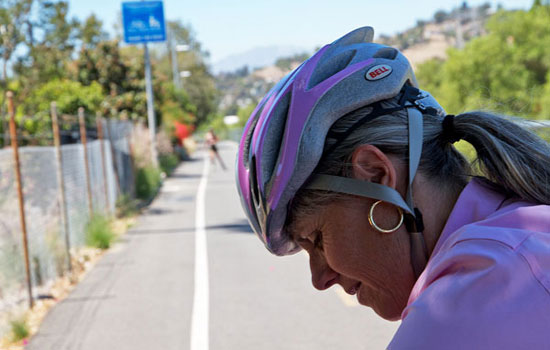
Senior bike coordinator Michelle Mowery has seen a sea change in attitudes about biking in Los Angeles.
You’ve got to hand it to Michelle Mowery. For two decades, she’s persevered, holding the job of “bicycle coordinator” in the nation’s most car crazy city. “A candle in the wind,” she calls herself. Make that a hard-blowing headwind.
But now, almost overnight, Mowery’s mandate has found a powerful constituency in City Hall and on the roads, giving her once-invisible position in the Los Angeles City Department of Transportation rising stature.
“We’ve put in more bike lanes in the past two years than during my entire career here,” she says. “We have a lot of work to do, but we’re getting stuff done.”
The latest achievement came this week, when Gov. Jerry Brown signed a law requiring California motorists to stay at least 3 feet away from cyclists when passing—a requirement already in effect in 22 other states. Four earlier versions of the measure had died because of various safety and liability concerns.
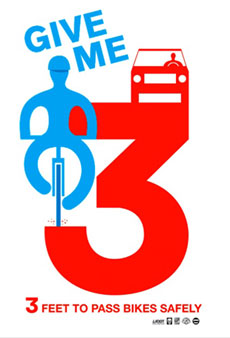 When Mowery heard the news on Monday, she says one word came to mind: “Finally.” For years, she had championed such a law, alongside elected officials in Los Angeles and bicycle advocates statewide. She praises the measure as “a start and an acknowledgement that cyclists need that little bit of space to stay safe.” It will take effect next September.
When Mowery heard the news on Monday, she says one word came to mind: “Finally.” For years, she had championed such a law, alongside elected officials in Los Angeles and bicycle advocates statewide. She praises the measure as “a start and an acknowledgement that cyclists need that little bit of space to stay safe.” It will take effect next September.
According to the California Bicycle Coalition, which launched a “Give Me 3” campaign with Los Angeles advocates to give visibility to the issue, passing-from-behind collisions are the state’s leading cause of bicyclist fatalities. In fact, Mowery says, a galvanizing moment in the long effort to win passage of a buffer zone for cyclists came in 2006, after popular UC Santa Barbara triathlete Kendra Payne was struck and killed by an asphalt truck that tried to pass her on a sharply-curving road.
Mowery says existing California law simply states that drivers must keep a “safe distance” when passing cyclists, a subjective standard. Now, she says, law enforcement has been given a specific tool to cite motorists who invade a rider’s legal space. Even if police don’t make enforcement a top priority, the legislation’s educational value alone could save lives, says Mowery, a lifelong cyclist who’s now 54. She added that this is especially true in Los Angeles, where riders often need more room to dodge bad pavement conditions. “They’re not always able to ride in a straight line,” she says.
Mowery attributes the growing clout of cyclists to shifting demographics. She says that when baby-boomers like her learned to drive, the region’s freeways were new “and wide open. It was the land of opportunity for cars.” These days, however, the under-30-crowd is driving less, while increasing numbers of teenagers are deciding not to even get drivers licenses.
“They see people sitting in traffic and it doesn’t look like fun,” Mowery says.
Eric Bruins, planning and policy director of the Los Angeles County Bicycle Coalition, agrees, calling this “a golden era for bikes.” The new buffer-zone law, he says, is a “huge” step forward. “For us on the street, this is something we encounter every single day. Everybody just needs a better understanding of what it means to pass safely, and that’s what this law provides.”
Bruins credits Mowery with being a leading force behind the new law through her advocacy in Los Angeles and as a member of statewide cycling organizations. “I don’t think the bike community has understood what a quiet champion she has been…She’s been trying to get this [law] passed forever.”
Bruins says that, for years, Mowery had been a controversial figure, the public face of City Hall recalcitrance to demands for more bike friendly streets. But now, with the growing influence of Los Angeles cyclists, Bruins says, the city’s bike boss is riding high.
Says Bruins: “She is finally empowered to do her job.”
Posted 9/26/13
Getting fired up over e-cigarettes
July 11, 2013
These days, e-cigarettes are smokin’ hot.
That guy sitting next to you in traffic, puffing on a pipe-like cylinder as clouds of vapor billow around his head, isn’t getting high—he’s ‘vaping.’
“Vape shops” are suddenly everywhere, some of them offering a lounge-style atmosphere for firing up and partaking of hundreds of flavor options—ranging from AppleCinnana to Yummy Gummy—for the nicotine-infused “e-juice” that creates vapor and delivers an adjustable dose of nicotine.
Big Tobacco is getting in on the act, too, with the makers of Marlboro and Camel preparing to sell their own brands of e-cigarettes, and the company that produces Newports buying the e-cig brand Blu.
But where there’s vape, there’s worry. Even though e-cig users contend that vaping helps reduce or eliminate their craving for dangerous regular smokes, public health experts, government officials and anti-smoking groups say it’s way too soon to assume the new devices are safe. E-cigs, they say, pose potential health hazards for smokers and those around them, and more study is needed to establish the risks.
“It is alarming that we’re seeing so many of these,” said Linda Aragon, director of the county’s Tobacco Control and Prevention Program. “You see a lot more of these vaping stores, or even vapor lounges that are popping up all over the place. We’re seeing much more of that than we have in the past.”

Marketing campaigns include bringing in Playboy's Miss November, Brittany Nola, for an e-cig launch party in New York.
Nicotine is, of course, highly addictive, and there are concerns that e-cigarettes’ kid-friendly flavor palette could attract underage smokers, or even pose an overdose hazard, particularly for small children who happen upon one of the “e-juice” flavor canisters. Researchers have found that propylene glycol, one of the main ingredients in the liquid, can be an irritant when inhaled. Concerns also have been raised about what happens when an array of potentially harmful substances found in some e-cigarettes are vaporized and inhaled by e-smokers and bystanders.
Los Angeles County, acting on motions by Supervisor Zev Yaroslavsky, has banned traditional cigarette smoking on beaches and in county parks, and requires tobacco retailers in unincorporated areas to be licensed. But it has not yet taken steps to regulate e-cigarettes, which can legally be sold in California to customers 18 years of age or older. The state Senate recently approved a bill by Senate Majority Leader Ellen Corbett that would make e-cigs subject to California’s smoke-free laws and ban their use in workplaces, public buildings and other locations that currently prohibit smoking. That bill is working its way through the Assembly and could reach Gov. Jerry Brown by this fall.
“We’ve worked hard to protect the public’s health by banning smoking in places where non-smokers would be adversely impacted,” Yaroslavsky said. “This new trend is a giant step backward from those efforts. Hopefully, the state legislature and the governor will solve that problem before the summer is over.”
Some municipalities around the state also are scrambling to impose e-cig restrictions, ranging from banning their use in public buildings to imposing a moratorium on new vape stores.
Starbucks has cracked down, too, banning e-cigs—along with the traditional kind—in its outdoor seating areas as of this June 1. And the issue’s gone global, with the World Health Organization this week joining the chorus of those urging caution in the use of what it terms “electronic nicotine delivery systems.”
Such warnings come against a backdrop of surging e-cig use. The federal Centers for Disease Control and Prevention reported that 21% of cigarette smokers have tried the electronic version, up from 10% in 2010.
The U.S. Food and Drug Administration says that consumers should not assume e-cigarettes are safe until more testing is done. In 2010, the FDA issued warning letters to five manufacturers for violations including “unsubstantiated claims and poor manufacturing practices.”
Vapers often say that e-cigs have made it easier for them to cut down on regular cigarettes or even to kick the habit altogether.
Aragon, of the county’s tobacco control program, doesn’t buy it.
“The reality is that there haven’t been enough studies to show that there is a sustained ‘quit,’ ” she said. “Our position is that folks who are trying to quit smoking should always use FDA-approved cessation resources, like nicotine patches, nicotine gum, Wellbutrin.”
Greg Simidy, a 21-year-old student who lives in Los Feliz, recently started vaping and said it enabled him to quit regular cigarettes “cold turkey.”
“I got into it with the intention of quitting smoking,” Simidy said, adding that he also “got into it because I saw everyone was doing it.”
On a sunny late morning this week, he was in a newly opened Hollywood store, Vaping Ape, looking to upgrade his equipment. “I want something that gives me the smoke, that feels better in the hand,” he said. And with the availability of tasty flavors like his current favorite, banana nut bread, he sees no reason to turn back.
“I think [cigarette] smoking is a thing of the past, to be honest,” he said.
One of the store’s owners, Jake Bautista, said his customers range from 18-year-olds to “a couple from Burbank in their mid-60s. They come in here every weekend and try new flavors.”
While Bautista said most of his customers want to quit smoking regular cigarettes, there’s also a cadre of style-conscious hobbyists out there who are attracted to the image e-cigs project.
“A lot of younger guys who are into fashion and shoes and stuff, they see their friends blowing clouds and they want to blow these big clouds,” Bautista said.
Bautista contends his product is safer than regular cigarettes and appealing for a number of other reasons, including that it leaves behind no tell-tale tobacco odors.
Michael Jay, a 21-year-old private chef from Oxnard who dropped into the Hollywood store this week, said vaping has helped him cut down his cigarette use and also improved his sense of taste and smell as he cooks.
He’s even turned his parents on to his new hobby.
“My mom and my dad smoked for 20, 30 years and they’re now using vapes,” he said. “It’s good to be able to help them.”
His folks are less enthusiastic, he said, about his rapidly expanding collection of e-cig flavors, which can range in price from $10 to $28, while starter kits for the smoking apparatus start at $65 and can go up to $350.
“I have a fanny pack full of flavors,” he said, rapidly ticking off “gummy blood, unicorn blood, blueberry lemonade, Belgian breakfast, crankberry, dragon’s breath, everything under the sun…They’re very customizable. It’s user-friendly now.”
Posted 7/10/13
The $6 billion question
October 10, 2012
On November 6, voters will have some important choices to make—and here in California, the vote on Proposition 30 is as crucial as they come.
The Board of Supervisors voted this week to formally support Prop. 30, a temporary but essential measure that would avert devastating cuts in education by raising personal income taxes for our state’s highest earners—those making more than $250,000 a year—for seven years, while increasing sales taxes by ¼-cent for the next four years. If approved, Prop. 30 would bring in an estimated $6 billion a year, with 89% of that going to K-12 education and 11% to community colleges.
The measure, put forward by Gov. Jerry Brown, also includes something that’s especially important to all of us in Los Angeles County: a local funding guarantee for state-imposed public safety realignment programs. This guarantee means that the state can’t send thousands of prisoners into Los Angeles County without providing us with the funds required to deal with the influx, and all the resulting public safety issues that go along with it.
Clearly, Prop. 30 is not an ideal solution. Raising taxes, even temporarily on those most able to afford the increase, is never fun. But this is a far-from-ideal situation we’re dealing with here.
Sacramento’s fiscal mess has been decades in the making, and deep spending cuts are needed to dig out of the hole. Prop. 30 aims to offer some relief on the revenue front.
This election is so important on so many levels. As you prepare to cast your ballot, I urge you to take the time to learn more about this proposition.
Here is a link to the motion I co-authored with my colleague, Gloria Molina, along with the analysis from the state Legislative Analyst, posted on the Secretary of State’s website for the November election.
And if you haven’t registered to vote, there’s no time like the present. You can even do it online, thanks to a pilot program by our county Registrar-Recorder. Just click here.
Posted 10/10/12
A “new day” for First 5 LA
July 17, 2012
It has been less than a year since Los Angeles County threatened to take over First 5 LA.
Created by voters to channel tobacco-tax revenues into programs for babies, toddlers and preschoolers, the independent agency had been accused of sitting on more than $800 million. A scathing audit had accused the organization of mismanagement and overstaffing. Meanwhile, much-needed initiatives for local kids were falling by the wayside.
What a difference nine months can make.
Last week, the commission overseeing First 5 here approved an accelerated plan to unleash nearly $400 million for services for the county’s littlest residents.
The plan, which is expected to serve up to 200,000 children countywide over the next five years, will almost immediately expand several existing programs and create some important new ones.
Among the new initiatives: a $25 million push to launch permanent supportive housing for homeless families with small children; a $40 million expansion of dental care for children age 5 and younger, and an innovative $4.1 million partnership with UCLA to bring mobile vision care to preschoolers starting in September.
Additionally, First 5 will spend more than $100 million to partner with the county on expanded programs to bring health insurance to low-income children and to address childhood obesity, parenting problems and substance abuse among parents of young children.
That money will be tied to multi-year agreements to ensure ongoing funding, and fast-tracked to the Department of Mental Health, the Department of Public Health and other partner agencies so that they can immediately qualify for funding matches.
“What’s impressive is not just the amount of money, but the speed, which is so important in light of the needs of our 0-5 kids,” says First 5 Chief Program Officer Antonio Gallardo. “First 5 used to be known for taking forever, but all these things are primed to be implemented in the next three to six months. That’s a 180-degree turnaround from the way we used to do business.”
First 5 was created in 1998, after California voters approved Proposition 10, a 50-cent tax on tobacco products that was championed by actor-director Rob Reiner. The money was to be locally administered and dedicated to child development programs for children aged 0-5.
Almost from the start, the tax generated immense sums. In most of the state, the revenues were administered directly by the counties. In Los Angeles, however, First 5 was overseen by a county-appointed commission and run by an independent agency.
Gallardo says that initially, the money piled up because it took several years to assess needs and to set up First 5 LA, the largest of the state’s 58 First 5 organizations. But when 2011 arrived with a local surplus approaching $1 billion, the untapped pots of money in Los Angeles and several other counties that had been slow to use their share of the funds became a tempting target for Gov. Jerry Brown, who’s been saddled with a huge budget deficit. He proposed diverting half of all the current and future Prop. 10 money into the state budget for children’s health.
The proposed diversion threatened to take about $450 million from First 5 LA’s swollen reserves, plus about $50 million into the future—a prospect that not only prompted a blizzard of lawsuits, but spurred Supervisor Michael D. Antonovich to ask Harvey M. Rose Associates to conduct the independent October audit.
The audit found no malfeasance, but was highly critical of the management under then-chief executive Evelyn Martinez, who had allegedly been so conservative with First 5 LA’s money and had operated with so little oversight by its commission that the organization was “at risk of not fulfilling its mission.”
“It was almost as if they were hoarding the money,” recalls Supervisor Zev Yaroslavsky, who, as this year’s chairman of the Board of Supervisors, automatically chairs the First 5 LA commission. “But the idea was not to have the biggest bank account in the county. It was to achieve the greatest positive outcomes for children who need help.”
Martinez resigned and general counsel Craig Steele took over as interim CEO in November after the Board threatened to strip First 5 LA of its independent status. Then in March, a court challenge invalidated the state’s claim to First 5’s revenues.
Now First 5 LA is searching for a new CEO. The new spending plan is expected to whittle the surplus to $122 million this fiscal year and $90 million by 2016.
Yaroslavsky, a longtime advocate for the homeless, says he is most excited about ambitious plans to jump-start housing and wraparound services for homeless children and their often-young parents, using a template that has been used successfully to house and treat other populations of street people, such as veterans and the chronically mentally ill.
“We have 3,000 kids in L.A. County below the age of 5 who are homeless, and that’s 3,000 too many,” he says.
But the supervisor also pointed with anticipation to a $4.1 million vision care program based on one that has been a remarkable success for the past decade in San Diego County, run by Dr. Stuart Brown, an ophthalmologist affiliated with both UCLA and UC San Diego. Brown says he expects to build on a small UCLA vision-mobile program to bring ongoing vision care to at least 20,000 preschoolers a year in this county.
“There’s plenty of money left, but we have moved a considerable amount out the door for programs and kids who need them,” says Yaroslavsky. “It’s a new day for First 5 LA.”
Blazing a path by the new Orange Line
June 27, 2012
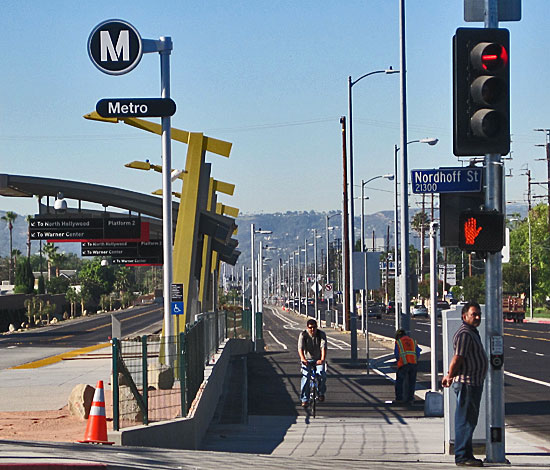
Even before it opens, the new Orange Line bike/pedestrian path is getting a workout. Photo/Dave Sotero, Metro
Bus passengers aren’t the only ones getting a slick new ride with this weekend’s opening of the Orange Line Extension.
The rapid transit busway features a dedicated bicycle/pedestrian path that’s being billed as the longest “transit-adjacent” bikeway of its kind in Los Angeles County. The path runs next to the new 4-mile northward extension of the Orange Line, which opens to the public this weekend with free bus rides on Saturday and Sunday, and connects with the original line’s 14-mile bikeway for a total of 18 miles. (By comparison, the newly-opened Expo Line bikeway is 6 miles long; it will grow to 16 miles when the line is completed to Santa Monica.)
Even before the ribbon is cut on the Orange Line Extension—which extends the popular busway northward from Warner Center to Chatsworth—cyclists and walkers have been giving the new path a workout. One project official counted 257 bicyclists and pedestrians out enjoying the new 4-mile stretch on a recent evening.
“I use it every day,” said Manny Samuel. “It’s safer for me [than the street] with all these cars.”
For Samuel, the bikeway even makes possible an old-fashioned midday break that most modern-day Angelenos can only dream of. “I’m going home for lunch,” said Samuel, who works at a nutrition research company, as he prepared to pedal from Canoga Park to Woodland Hills.
Dan Flores, out walking on a recent sunny day, said he’s already hitting the path for an average of six or seven miles a day—on foot or on bike. It’s great exercise—and a nice way to beat high gas prices. “I have a big giant truck that costs me $10 just to turn it on,” he said.
For teenagers like Anthony Winn and Gianni Darienzo, the new bike path has emerged as the preferred route to that time-honored summer destination: the mall. Compared to getting a lift in the car, “riding a bike’s better,” Darienzo said, as he and Winn returned from a trip to the Westfield Topanga Shopping Mall.
Most of the wide, asphalt-surfaced path has separate, dedicated lanes for bicyclists and pedestrians. Still, there are some “multiuse” areas in which walkers and cyclists will share space. Wider-than-usual 6-foot curb ramps also will allow cyclists and pedestrians to get on and off the path more easily, especially when it’s crowded.
Landscaping remains nonexistent along much of the path, but several hundred trees, such as incense cedars and Chinese flame trees, are set to go in soon, along with drought-tolerant plants including trailing rosemary and fortnight lilies.
The overall bus project is coming in ahead of schedule and under budget by $61.6 million, having used just $154 million of the $215.6 allocated. The acceleration was made possible, in large part, by the passage of Measure R by county voters in 2008, said project manager Hitesh Patel. Patel said the bicycle/pedestrian path is only part of a host of healthy and environmentally friendly elements incorporated into the new busway, which also has some solar-powered lighting panels, bioswales to naturally filter runoff water and even recycled construction debris from the 405 Project, which has been crushed and used as an underground base.
Those who want to ride the new busway extension can do so for free on Saturday, June 30, and Sunday, July 1. (The free rides are being offered only on the extension portion of the Orange Line running from Canoga Park to Chatsworth.) There also will be family-friendly festivities from 10 a.m. to 4 p.m. on Saturday at the Canoga Park and Chatsworth stations.
Those include a group ride with Valley Bikery, which sets out from the Canoga station at 1 p.m. and finishes at the Chatsworth station.
Nathan Baird, bicycle coordinator for the Los Angeles Department of Transportation, said he expects to see cyclists using the bike path—and the Orange Line itself—in a variety of ways.
“Having the bike path right next to the transit gives you a whole slew of options,” he said.
And the sheer 18-mile length of the path is a major plus, he said.
“The miles are important,” Baird said. “It connects across the entire Valley.”
Those connections eventually will go even further.
In the not too distant future, he said, cyclists will be able to start on the Browns Creek bike path in Chatsworth, connect with the Orange Line bikeway, travel along dedicated bike lanes through stretches of Los Angeles and Burbank and end up on the L.A. River bike path, which in turn will open up new connections stretching all the way to Long Beach.
As Patel, the project manager, puts it: “It’s going to be a wonderful asset for the San Fernando Valley…and for bicyclists, runners and nature lovers across the county.”
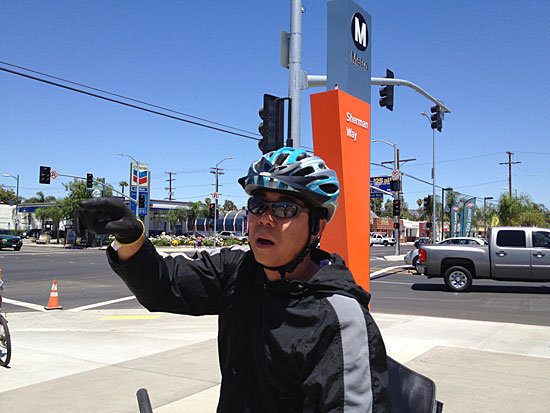
Manny Samuel, who lives in Woodland Hills and works in Canoga Park, uses the bikeway to ride home for lunch.
Posted 6/27/12
Looking out for shelter pets
February 8, 2012
The Los Angeles County Board of Supervisors this week weighed in on a narrow-but-emotional debate over euthanasia in animal shelters, urging the governor not to repeal a suspended law requiring shelters to wait more than three days before euthanizing abandoned pets and strays.
The mandate, suspended since 2009, is one of more than 30 that Gov. Jerry Brown has sought to eliminate in the wake of the state’s budget crisis.
Signed into law in 1998 by Gov. Pete Wilson, and named for its sponsor, former Santa Monica state senator Tom Hayden, it has extended the lives of lost and stray animals by requiring shelters to hold them from four to six days, rather than the 72 hours under the prior law. Local governments are supposed to be reimbursed by the state.
As California’s economy has struggled, however, the shelter law has been a target. In 2004, Gov. Arnold Schwarzenegger briefly tried and failed to repeal it, and five years later, it was suspended as part of a deal to balance the state budget. At the time, animal rights groups feared that shelters would begin euthanizing animals more quickly, but they continued to abide by longer waiting periods, making up for the lack of state reimbursement out of their own budgets.
In Los Angeles County, for instance, the Department of Animal Care and Control has spent about $600,000 a year of its $33 million budget to hold animals for five days before euthanization, says Chief Deputy Director David Dijkstra.
“As long as we have the ability, we like to make animals available for adoption or owner redemption for as long as possible,” Dijkstra says, noting that the county impounds about 90,000 animals a year and euthanizes fewer than half of them.
Some animal rights activists have argued that Hayden’s Law has worsened conditions for shelter animals because so-called “rescue holds” by hoarders and well-intentioned but disorganized animal lovers force shelters to house aggressive and diseased animals for weeks at the expense of more adoptable pets who then end up being euthanized for lack of space.
The state also points to a 2008 report from the nonpartisan Legislative Analyst’s Office that found no proof that the Hayden Law had led to an increase in pet adoptions, and therefore recommended repeal.
Still, Brown’s proposal to save more than $23 million a year by taking the mandate out of the state budget has drawn a fresh round of protest from some pet lovers and animal rights groups. Hayden recently spoke out in a YouTube video, and the Humane Society of the United States this week asked members to write to Brown.
The Board’s response, led by Supervisor Michael Antonovich, a longstanding advocate for pet adoptions, took the form of a 5-signature letter asking that the law not be repealed.
Quantifying the local impact of Hayden’s Law has been difficult because so many variables are involved in pet adoptions. For example, in recent years, Dijkstra says, shelters have become more crowded because owners have had difficulty caring for pets in this economy. Moreover, many of the 40,000 or so animals euthanized each year in county shelters are animals such as feral cats that can’t easily be placed for adoption.
However, he notes, by the most available measure—dog impounds—the suspension of Hayden’s Law has not increased euthanasia. In 2008-09, the county impounded 45,903 dogs, with 54 percent adopted or returned to their owners. In 2011-12, the projected number of impounded dogs stands at 48,823, with 57 percent returned or adopted.
About 80 percent of pets are claimed by their owners within the first three days, he says, but last year, about 1,100 lost pets were reunited with their owners on their fourth and fifth days in the shelter. In the past year, he adds, the county also has begun putting abandoned pets up for adoption sooner than they might otherwise have been made available.
“It’s very rare that an owner shows up after we’ve made a dog or cat available for adoption,” he adds, “but that has happened on a couple of occasions, and in those cases, the new owners are contacted and asked if they’ll give the pet back.”
Posted 2/8/12
Realignment gets all too real
October 6, 2011
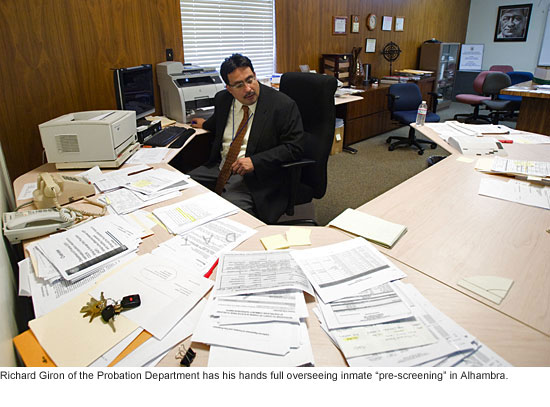 Inside a cramped, dingy-white building in Alhambra, one of California’s most radical—and some say reckless—experiments in its criminal justice history is unfolding. There, officials are getting a detailed first look at some of the thousands of state inmates who’ll be supervised by Los Angeles County once they’re freed, a process that began this week.
Inside a cramped, dingy-white building in Alhambra, one of California’s most radical—and some say reckless—experiments in its criminal justice history is unfolding. There, officials are getting a detailed first look at some of the thousands of state inmates who’ll be supervised by Los Angeles County once they’re freed, a process that began this week.
So far, it’s not an encouraging sight.
Hundreds upon hundreds of prisoner files—some woefully incomplete—are haphazardly arriving by mail, fax and Fed-Ex at Los Angeles County’s “pre-screening” hub in the Probation Department’s Alhambra field office. Eagle-eyed probation workers are uncovering mistakes, large and small, in the state records, including inmates who should be sent to other counties and others whose crimes should disqualify them entirely from the new “realignment” program.
Only late last week, after intense pressure from L.A. County, did state corrections authorities even begin sending comprehensive mental health records on ex-convicts headed here for supervision, information that’s crucial in developing treatment plans for the clients and protection for the public.
What’s also become increasingly clear in recent days is that the state has not been entirely forthcoming about the fine print of the controversial realignment plan, which is aimed at reducing prison overcrowding while slashing the state’s budget deficit.
Again and again, the governor and legislature have publicly stressed that the ex-inmates who’ll be supervised by the counties are “low-level” offenders convicted of non-serious, non-violent, non-sexual crimes. They also note that these individuals would have returned to their home counties no matter who was responsible for their oversight. But that’s not the whole story, as L.A. County officials are quickly learning.
These same felons could—and sometimes do—have prior cases involving very serious crimes. Under the realignment law, AB 109, only the most recent conviction, or “commitment offense,” is considered in determining whether inmates will be supervised by counties or state parole agents after their release.
Take, for example, one inmate who was scheduled to be freed on Wednesday and has been ordered to report to L.A.County for post-release supervision. He was serving time for second-degree commercial burglary, attempted grand theft of personal property, forgery and identity theft—all non-serious, non-violent crimes under the penal code. But over the previous decade, he had more than a dozen arrests or convictions for a slew of serious and violent crimes, including assault with a deadly weapon, robbery and terrorist threats.
“We’re literally seeing every criminal record you could think of,” says Richard Giron of the Probation Department, who’s in charge of the pre-screening center in Alhambra, where nearly 2,000 files have been received. “We’re seeing prior violence, prior sex offenses—the full range of minimal criminal records to extensive, serious records.”
Giron says his staff is flagging such individuals for heightened supervision as part of the case plans developed when inmates arrive at other hubs throughout the region for face-to-face interviews.
Reaver Bingham, the Probation Department’s deputy chief of adult services and juvenile placement, called some of the county’s new charges “very hard core” but insisted that his agency is trained and prepared to deal with them. “This population is not unfamiliar to us,” he said, noting that the department currently supervises 15,000 adults with histories of serious and violent crimes.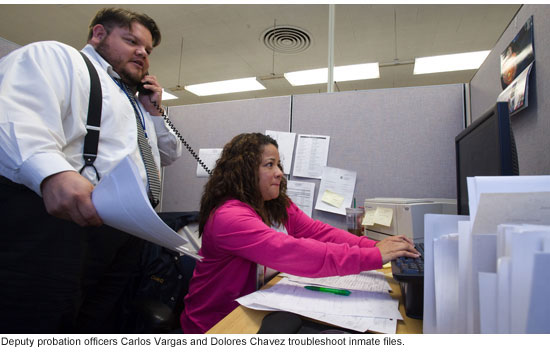
In recent weeks, as AB 109’s October 1 implementation date drew near, concerns about public safety took center stage, with the harshest warnings coming from Los Angeles County District Attorney Steve Cooley. He predicted that crime rates would soar not only because of the freed inmates who’ll be under county supervision but because, under the law, defendants convicted of non-violent, non-serious crimes will now be sentenced to county jail rather than state prison. He and others argue that this will lead to even greater jail overcrowding and more inmates being released early by the Sheriff’s Department, which manages the sprawling system.
In the Alhambra screening center, Giron and his hand-picked team understand the high stakes for public safety and are determined to make sure no inmate is erroneously placed under the county’s jurisdiction. His 11 deputy probation officers and two supervisors scour every document the state sends and then comb criminal databases, as well as court records, for additional information on each of the inmates scheduled for release.
In the process, Giron says, his staff has uncovered mistakes that have given county officials ammunition to keep dozens of inmates from falling under probation’s purview.
“I’m doing everything I can in my power to reject cases that are inappropriate for supervision in L.A. County,” Giron says. Those cases have included an inmate who’d been serving time for molesting a child under the age of 14, a prisoner convicted of a serious extortion attempt and yet another who was described by the state’s own prison board as not safe to be released.
On Wednesday morning, Deputy Probation Officer Deanna English, a 22-year veteran of the department, found yet another, using the scant information contained in the state’s own file as a springboard.
Corrections officials had determined that a 20-year-old inmate at the California Rehabilitation Center in Norco was eligible for county supervision because, according to a release form, he was serving time for a second degree burglary. But that was wrong. Contained within the file itself was the notation that he’d been sentenced for a robbery, a serious crime that would exempt him from the realignment program. English says she then checked the actual court record, which confirmed the robbery conviction.
“Honestly speaking, I thought they were trying to pull one over on us,” she says of corrections officials. “Their thing is to get as many [inmates] out of the state system as they can.” English says she feels “a high sense of duty” to thoroughly vet every file.
Making the job even more challenging for the Alhambra crew is the fact that the state has no centralized point of contact. The county is receiving files from 33 separate prisons. And those files are not being sent based on the chronological release dates of inmates, dates that seem to be constantly shifting.
Just the other day, as Giron talked with a visitor from Supervisor Zev Yaroslavsky’s office, another probation supervisor, Al Montellano, walked up with a handful of documents fresh off the fax. They stated that eight inmates scheduled for release on December 4 will now be freed on October 23, meaning that the time-consuming review of their cases will have to be rushed into the mix, putting others on hold.
“That,” Giron says with a hint of understatement, “is operationally inefficient.”
Progress finally has been achieved, however, in one of the most crucial facets of the screening process—determining the mental health status and needs for the estimated 20 percent of inmates coming to the county who’ll need some level of treatment.
For months, the Los Angeles County Department of Mental Health, a key player in the realignment process, had been stymied in its efforts to obtain comprehensive treatment records for inmates. The information provided by the state was simply a notation that mental health services had been delivered in prison.
“We were getting promises and assertions that were not true,” says Dr. Marvin Southard, director of mental health. “It was very frustrating.”
Among other things, Southard says his department was directed to dial an information number on the inmate forms. “If you call that number, you get a correctional counselor—the cell-block staff person—but they have no access to the medical records,” Southard says.
Further, according to Southard, his staff was told that they’d have to individually contact each of the state’s 33 prisons for information, which would consume crucial time in learning an inmate’s needs and creating a treatment plan.
The issue reached a boiling point two weeks ago when the Board of Supervisors voted to send a stern letter to Gov. Jerry Brown. In it, they warned that, unless the necessary information was forthcoming, “we will not accept parolees with mental health issues.”
“After that, everything changed,” Southard says, noting that a centralized system was developed by California’s corrections officials. “The governor’s staff promised that we’d get the records we need.”
Still, even if the county manages to overcome all these logistical challenges, there’s still the overarching question of whether the state will provide the money necessary to make it all work today and in the future.
“This has been my concern from Day One,” says Supervisor Yaroslavsky. “We’ve been asked to take a leap of faith that the reimbursement is adequate to meet our responsibilities. You can’t blame us for being skeptical, especially given the problems that have emerged in the opening days of this program. Even though the governor has assured us he will make us whole, it’s not entirely up to him and that makes me nervous.”
Posted 10/6/11







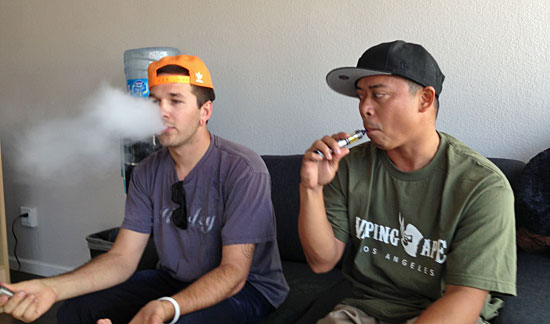


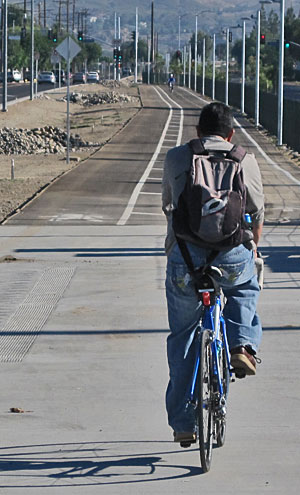

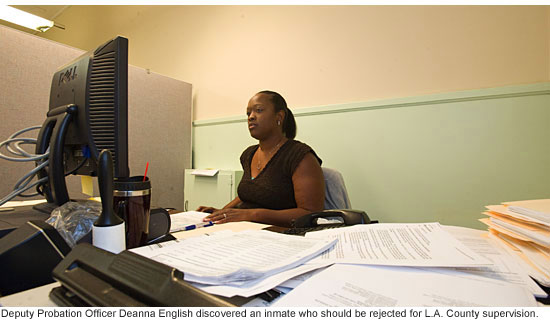







 405 bridge work causes a stink
405 bridge work causes a stink

